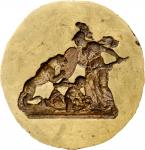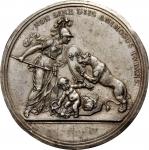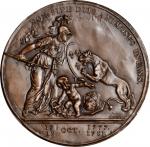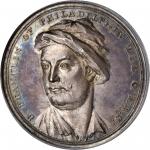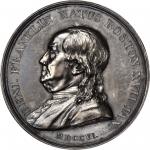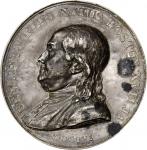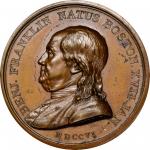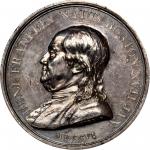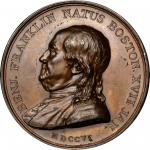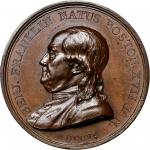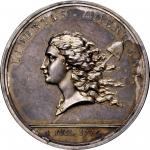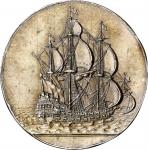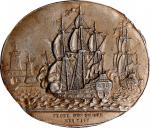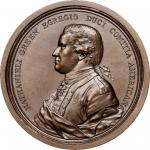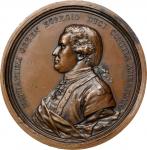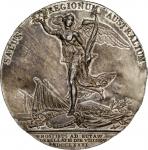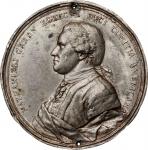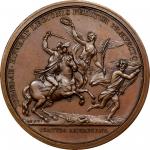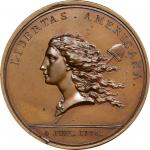1781 Libertas Americana medal. Betts-615. Copper. Original. Paris Mint. 47.8 mm, 725.8 grains. 3.5 - 3.6 mm thick. Choice Mint State.Plain concave edge. A medal of elegance and beauty, a specimen that upholds this medals reputation as the peak of Dupres artistry. Rich chocolate brown with undertones of pale olive, faded rose, pastel blue, and light gold over the reflective fields. Just a gorgeous example, with fully struck detail and only a trivial degree of handling. Scattered tiny marks, including a patch in the lower left obverse field, do nothing to detract from this dazzling survivor. A natural flaw on the inside step of the obverse rim above AS of LIBERTAS is seen, as struck, and the obverse rim was gently filed to reduce a fin (or "wire rim"). The reverse peripheral legend shows some evidence of the multiple striking required to raise these details. The die state is advanced here, the latest of the three examples in this collection, with the obverse break beneath 4 reaching its fullest extent. While the spalling pit beneath the second A of AMERICANA is a bit larger here than on earlier strikes, the spalling trail in the lower right obverse remains fairly stable over the course of the die state continuum.<p>It is well known that Benjamin Franklin preferred Dupres majestic design in copper. "The Impression in Copper is thought to appear best," Franklin wrote to Robert Livingston on April 15, 1783, though one wonders if he might have written something different if the piece he enclosed for Livingston was a silver one. Copper specimens like this one were sent to the members of Congress and other functionaries close to the government; it seems likely that more copper pieces were distributed in the United States than in France.<p>Cognizant of the historic moment they occupied, and appreciative of Franklins largesse, it seems that most recipients of a Libertas Americana medal cherished it. The bulk of the mintage seems to have survived. Of course, to an 18th century non-numismatist, cherishing something meant handling it, displaying it, perhaps cleaning it now and again, thus few survive in Gem condition. The total population - perhaps 200 or so - is heavily weighted toward those with some handling. Not one in ten is as nice as this one.<p><strong>The Libertas Americana Medal</strong><p>There is almost nothing we can say about the Libertas Americana medal that has not been said before. It is the most recognizable early American medal, the unanimous choice as #1 in the <em>100 Greatest Medals and Tokens book,</em> and the inspiration for many of the United States coinage designs of the 18th century. It is legendary beyond its rarity, historic beyond its celebrated creation narrative, and important far beyond the world of numismatics.<p>While not properly a part of the Comitia Americana series - it was a medal authorized by Benjamin Franklin as an individual, not the Continental Congress - the Libertas Americana medal has been adopted into this group ever since Thomas Jefferson saw fit to place one in George Washingtons set of Comitia Americana medals in the summer of 1789. By that time, the medal was several years old, as it had been completed and distributed by Franklin in the spring of 1783. Franklin sent his medal far and wide, in France, in the United States, and beyond. His postal accounts show that in April 1783 he twice hired a carriage to special deliver his medal to its recipient. Jefferson had one on display at Monticello, inventoried as "a medal by Dr. Franklin." The Dutch artist Johann-Georg Holtzhey had a friend write to John Adams to ask how he and his friends could obtain one. As the medals found their homes in April and May 1783, Franklins mailbox filled up with thank you notes from across the continent. On April 15 of that year, Franklin sent a bundle of them to Philadelphia to hand out to the members of Congress, including a silver one for Congress president, future Mint Director Elias Boudinot. <p>In September 1783, Franklin wrote to Boudinot "I am happy that both the Device and Workmanship of the Medal are approvd with you, as they have the good Fortune to be by the best Judges on this side the Water. It has been esteemd a well-timed as well as a well-merited Compliment here, and has had good Effects. Since the two first which you mention as received, I have sent by different Opportunities so many as that every Member of Congress might have One. I hope they are come safe to hand by this time." Boudinot confirmed their arrival and described how he parceled them out: "I have received the additional number of Medals, which, not having any particular directions from you, I distributed among the Members of Congress, presented one to the Governor of each State, and the Ministers round Congress."<p>Every Libertas Americana medal was once handled by Franklin, every great American and Frenchman of the era knew about the medal and associated it with Franklin, and every Libertas Americana medal surviving today has a remarkably historic provenance, whether it is fully documented or not.<p>The quoted descriptions of the medal come from the explication published in France in May 1783, quite possibly written by Franklin himself. This explication was printed as a leaflet and intended to accompany the medal itself.<p><strong>Obverse:</strong> "The Head representing American Liberty has its tresses floating in the air, to shew that she is in activity. The Cap carried on a Spear is her Ensign. The Date underneath is that of the Declaration of Independence."<p><strong>Reverse: </strong>"The United States of America are represented by an Infant Hercules, cradled in a Buckler to shew that they are nursed in War. A Leopard, representing England, comes with two serpents to destroy the Infant. France represented by a Minerva, comes armed to his succour, and under her protection he strangles the two serpents, while she guards him from the Leopard, by her shield marked with Fleurs-de-Lis. The Legend is a line of Horace, importing that the Infant was not without divine assistance. The Dates below are those of the two Capitulations of Saratoga & York-Town, whereby two entire English Armies that had enterd and ravaged the United States with fire & sword, were extinguished." In Franklins symbolism, this depiction recalls Hera, the stepmother of Hercules, releasing two snakes to kill Hercules in his cradle; those two snakes were the armies of Burgoyne (defeated at Saratoga) and Cornwallis (defeated at Yorktown).<p><p><p>From the John W. Adams Collection. Acquired from Ted Craige.


